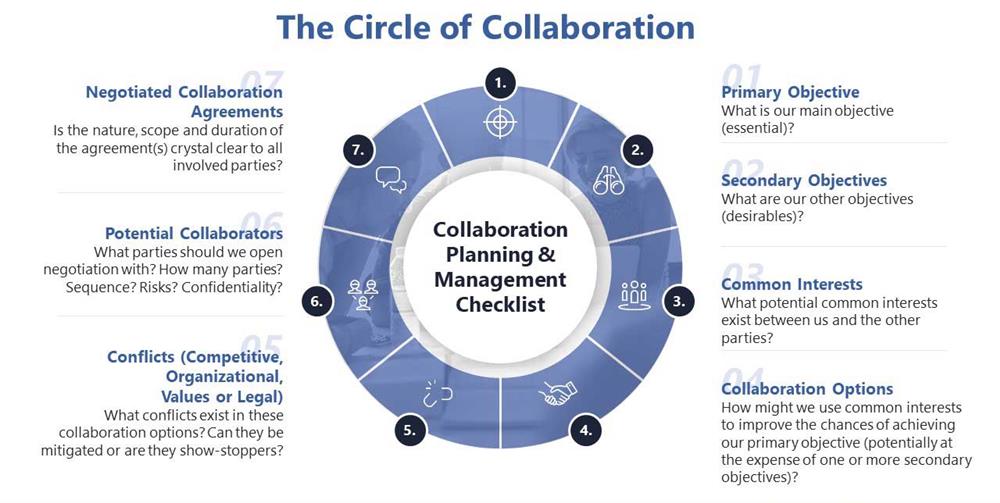We have developed a great little tool which we call “The Circle of Collaboration”” which combines best practices in collaboration and negotiation (such as the “Getting to Yes” principled negotiation technique). The Circle of Collaboration can help you focus on the most important objective and not get sidetracked by secondary objectives as we so often do.
As the late Stephen Covey used to say “The main thing is to keep the main thing the main thing”.
Sub-optimum Organizations
A key principle of effective systems is that they, somewhat counter-intuitively, “sub-optimize the parts to optimize the whole”.
However, many of our organizations are riddled with systems where we end up doing it the wrong way round – "optimizing the parts and thus sub-optimizing the whole".
This leads to silo-thinking, short-term behaviour, competition between departments and sub-optimum performance.
The Circle of Collaboration is summarised in the diagram below – lets illustrate it with a very simple example – two departments working together to deliver an important project.

Figure The Circle of Collaboration
A Simple Project Example
First each department needs to ask itself what are its primary objectives and what are its secondary objectives.
This is where it usually starts to go wrong!
The primary objective should be to deliver the project on-spec, on-time, on-quality and on-budget - everything else is secondary.
Typical secondary objectives include:
- Delivering our part of the project
- Not being blameable if (when) the project goes wrong
- Not exceeding our department's project budget
- Enhancing our departments reputation with the project sponsor, steering committee and senior management
- Not being seen to be weak or needing external help
What often happens is that each department inverts the secondary and primary objective - this is usually unstated which makes it particularly deadly!
To address this objective flipping, we need to explore and find genuine common ground with the other department – for example the business necessity for both departments for this project to succeed.
Then we need an honest conversation between the departments about what is making us invert the primary and secondary objectives and what we can do to stop it .
Practical solutions we might brainstorm together could include:
- Agreeing not to bad-mouth or blame the other department to the sponsor etc
- Combining our budgets into a single pot
- Issuing a single project update report rather than one per department
- Having an agreed escalation process for problems
- Having a hot-line between the two departmental heads that is used when there is a serious risk of war breaking out
Practice Makes Perfect
One of the reasons silo-thinking is so prevalent is that we are not natural collaborators – competition is the default human state!
Therefore we have to train ourselves in collaboration or else we wont be able to do it when we need to.
A very effective way to do this is through team-based Business Simulations.
We have a portfolio of short Collaborative Working simulations which we call collectively The Collaboration Trilogy because they each develop different collaborative skills for leaders.
PLAYOFF is a fun Simulation where competitors need to partner together temporarily to win the big prize.
COMPETE is a Business Acumen scenario which is mostly competitive but with key places where some collaboration is in everyone’s interests.
CONSORTIUM is manufacturing scenario where companies must work together and share resources effectively to deliver a small test project successfully to win a massive contract.
We also have a very practical book “A Systematic Guide to Collaboration and Competition within Organizations” which can be used in conjunction with the Business Simulations and explores in detail the different types of collaboration and competition in organisations and how to get the best results in the different scenarios.